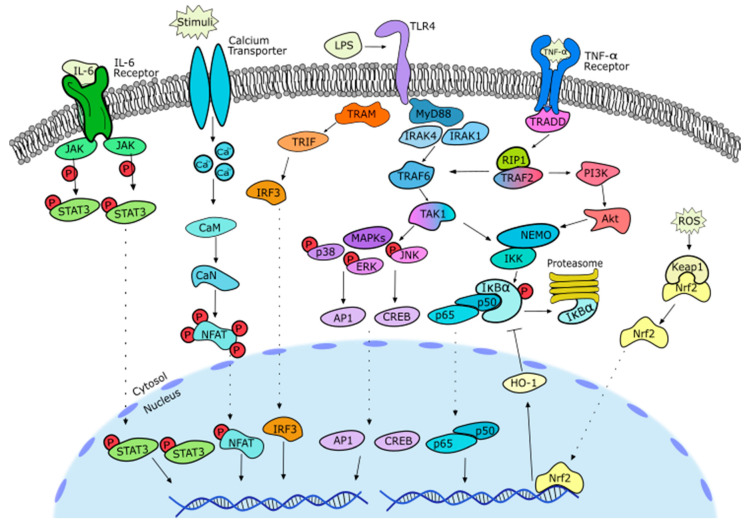Figure 11.
Inflammatory pathways upon which SLs have been described to exert an effect upon. IL-6—interleukin-6; JAK—Janus kinase; P—phosphate group; STAT3—signal transducer and activator of transcription 3; Ca2+—calcium ion; CaM—calmodulin; CaN—calcineurin; NFAT—Nuclear factor of activated T-cells; LPS—lipopolysaccharide; TLR4—Toll-like receptor 4; TRIF—Toll-interleukin-1 receptor domain-containing adapter inducing interferon-β; TRAM—TRIF-related adapter molecule; IRF3—interferon regulatory factor; MyD88—myeloid differentiation primary response 88; IRAK1/4—interleukin 1 receptor associated kinase 1/4; TRAF2/6—tumor necrosis factor receptor (TNFR)-associated factor 2/6; TAK1—transforming growth factor-β activated kinase 1; MAPKs—mitogen-activated protein kinases; p38—MAPKs member; Erk—extracellular signal-regulated kinase; JNK—c-Jun N-terminal kinase; AP1—activator protein 1; CREB—cyclic adenosine monophosphate (cAMP) response element-binding protein; TNF-α—tumor necrosis factor-alpha; TRADD—TNF-α-associated death domain protein; RIP1—receptor-interacting protein 1; PI3K—phosphatidylinositol-3-kinase; Akt—protein kinase B; NEMO—Nuclear factor-kappa B essential modulator; IκBα—NF-κB inhibitor alpha kinase; IKK—IκBα kinase; p50/p65—NF-κB protein subunits; HO-1—heme oxygenase-1; ROS—reactive oxygen species; Keap1—Kelch-like ECH-associated protein 1; Nrf2—nuclear factor erythroid 2-related factor 2.

